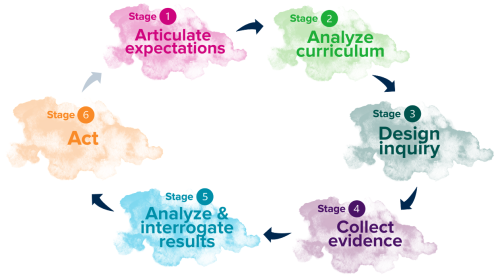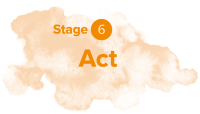
Program Stages
The Program-level Assessment Capacity Enrichment for Equity (PACE4Equity) program guides faculty-led teams through the six stages of the assessment cycle (shown at right; described below.) to build capacity for participating in and leading on-going equity-minded program-level assessment. A downloadable version of this page is located below.
Stage 1
Articulate and Communicate Expectations (2 months)

Teams learn the importance of articulating and communicating expectations for student learning. We explore the challenge experts face when articulating the characteristics of mastery in their fields and identify appropriate tools for defining and describing characteristics of attainment.
- Equity principles: Necessity of transparent, accessible, and agreed-upon student performance expectations; how and when to communicate expectations to students.
- Threshold concepts: Program learning outcomes (PLOs), performance indicators (PIs), performance levels (PLs), performance level descriptions (PLDs) for each performance indicator.
- Deliverable: Analytic rubric for one PLO that assembles all threshold concepts into a single, usable instrument for assessment of student learning.
Click to view the Stage 1 PLO Rubric Template.
Stage 2
Analyze Curriculum (1 month)

Teams explore the extent to which current courses in their programs provide opportunities for students to learn and demonstrate the performance indicators that constitute program learning outcomes. We address the iterative relationship between course-level instructional practices and program-level student outcomes.
- Equity principle: Aligning expectations for learning with curriculum realities.
- Threshold concepts: Curriculum alignment, levels of engagement, curriculum mapping, standards, and targets.
- Deliverable: Working draft of a program curriculum map; and articulated standards and targets for one PLO.
Click to view the Stage 2 Curriculum Map Template.
Stage 3
Design Inquiry (3 months)

Teams develop, design, and plan an in-depth inquiry project to assess student learning. The deliverables of Stage 1 and 2 are critical guides for this inquiry: the rubric developed in Stage 1 is operationalized in Stage 3, while the curriculum map developed in Stage 2 shows teams which courses/instructors need to be brought into the inquiry in order to observe performance indicators and, as a result, assess student learning in one PLO.
- Equity principle: Identifying characteristics of equitable evidence of student learning.
- Threshold concepts: Validity and reliability, direct and indirect evidence of student learning, aligning evidence to course-level assignments and learning experiences.
- Deliverable: An operationalized analytic rubric - developed in collaboration with course instructors - integrated into Canvas to assess student performance on (part of) a course assignment.
Click to view the Stage 3 Inquiry Plan Template.
Stage 4

Collect Evidence (3 months / 1 quarter)
Teams continue working with their collaborative partners (course instructors and program leadership) to finalize a data generation strategy. Some teams will train instructors, including teaching assistants how to use the rubric to assess students’ course work; others will convene a small group of faculty to use the rubric to assess (a sample of) student work from course(s). In this stage, teams finalize the preparations and “press play” on their data collection.
- Equity principles: Ensuring data are confidential, private, and representative.
- Threshold concepts: Data collection versus data generation, data collection plans.
- Deliverable: A body of course-level evidence of student learning - gathered in collaboration with course instructors - that was assessed with the rubric that was developed in Stage 1 and deployed in Canvas in Stage 3.
Click to view the Stage 4 Data Collection Plan Template.
Data preparation and visualization
Between Stages 4 and 5 course-level data gathered in Canvas are exported, synthesized, appended with student demographics, and de-identified to generate a program-specific data dashboard to visualize the results.
Stage 5
Analyze & Interrogate results (2 months)

Teams work with various partners to dig into the data collected in Stage 4 and synthesized prior to Stage 5. Teams will learn to ask questions of their data (and themselves) including: How do we engage in equity-centered data analysis? How does our interpretation of data reinforce or disrupt existing barriers to equity? How many PIs must students demonstrate mastery of in order to confidently say that they have mastered the PLO? What do these results suggest for the continuous improvement of our program?
- Equity principles: Operationalizing equity as parity; practices for equity-minded interrogation of disaggregated data.
- Threshold concepts: Data disaggregation and analysis, drawing inferences, thematic analysis.
- Deliverable: A set of findings drawn from careful analysis of the evidence drawn from Stage 4.
Click to View the Stage 5 Findings Template.
Stage 6
Act (1 month)

This is the culminating and most important stage of the PACE4Equity program. During this stage, teams will reflect on the totality of their PACE4Equity learning experience and develop evidence-informed action plans that support the continuous improvement of student learning in their programs. Action plans can be put to use by department leadership, become part of program review narratives, and indicate future program-level assessment needs.
- Equity principle: Parity as the starting point for exploring future actions.
- Threshold concepts: Interpreting results, evidence-based decisions, action plans versus assessment narratives.
- Deliverable: A written document that recounts your assessment narrative and articulates evidence-informed recommendations for action.